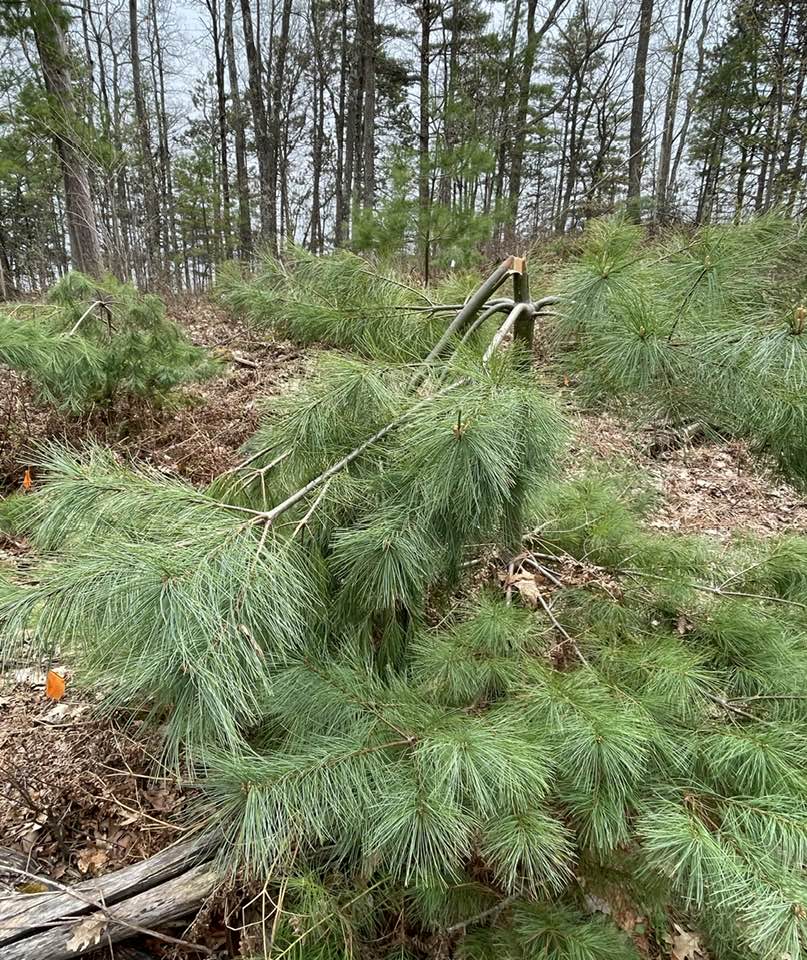MAY 12, 2023 – Today we made our first trip to the Red Cabin since the snow melt and ice-out. Vegetation here is 10 days to two weeks behind the foliage at home, which itself is well behind its usual schedule. In mid-March the snow was still two feet deep, and that was before the month-end snowstorm clobbered the area.
With all snow and ice gone and the temperature in the high 60s, our surroundings remind me of a person in shorts, T-shirt and sandals after a long, bitter winter in which that same individual was so heavily wrapped in Inuit garb as to be unrecognizable. I’d never have guessed that such contrasting appearances belonged to the same being.
After unloading the car, I ventured into the woods to my tree garden to check on the one-thousand young white pine that I’d laboriously bud-capped last fall to protect against browsing deer. In March I’d snowshoed to the entrance, but the snow was so deep, most of the young trees were obscured. The boughs of taller trees seemed to groan under the heavy snow loads.
Today, after climbing over several giants that had fallen across the trail leading to the tree garden, I climbed up the shallow slope to the Björnholm Trädgården sign that hangs above the entrance.
I was devastated by what I saw. Every single tree, from two-year-old seedlings to six-year-old saplings were in extremis. Many of the royalty—straight, well-formed pine that had grown two, three and more feet a year for the past five years—had been cruelly snapped in two. Others were bent at right angles. Still others had folded into each others arms, like doomed lovers facing a tragic fate. A number of trees, big and small, were still intact but flattened nearly to the ground. I was crushed by the sight, given all the time and effort I’d devoted to these trees and all my “envisioning” of the forest that would develop here in another 20, 50, 100 years.
I proceeded to pull off a few dozen paper bud caps that I’d methodically cut, folded and stapled to the trees last fall. For this removal effort my reward was four wood ticks and one deer tick.
As I dealt with the ticks and pondered the extreme weather that had assaulted the trees, I grappled with the knowledge that nature is a dichotomy of symbiosis and civil war. Humanity, a subset of nature, likewise pursues conflict and cooperation with itself—and with nature. We say we love nature, yet we harm it relentlessly in our insatiable compulsion to consume. In the case of extreme weather, growing evidence links it to anthropic climate change. The data confirm what I’ve observed anecdotally in our woods: torrential rains, more powerful winds, higher temperatures, more infestations.
How will these woods appear in time—even the intermediate and short-term future? I worry about the earth, our home. The prospects of transforming the moon or Mars into attractive alternatives hold none of the promise that earth has offered since the last Ice Age. Whether by the natural (dis)order of things or by our own over-consumption and arrogant denial, the earth as we’ve known it is changing faster than at any time during the Anthropocene.
I worry that the devastation visited upon my treasured trees is another portend of more untoward change. My heart aches, not only for “my” trees but for trees wherever they’re under stress; for all the earth—and for all the life it sustains.
Subscribe to this blog and receive notifications of new posts by email.
© 2023 by Eric Nilsson
